*******
Before I get into this post, I just realized that today marks a milestone for this little blog. Seven years ago today, I dipped my toe into the world of food blogging by launching Tuna Toast with this post. I thought I’d link to the original Blogger version since that was what I started on (I’ve since graduated to WordPress, thankfully!). I just wanted to say “thanks” for reading- if you still are- and for sticking around through the lulls in posting. Seven years- whoa. Ok- now onto the gyoza!
*********
I am lucky enough to have two parents who are great cooks. Growing up, my sister and I woke up to toast with cinnamon sugar or buttered and topped with sardines (to this day, a favorite!), waffles, freshly fried corn or apple fritters which my dad would whip up on the weekends or huevos rancheros with perfectly runny eggs . Our lunch boxes were packed with my mom’s delicious egg or tuna salad sandwiches, and we always- always- sat down as a family to a homemade dinner. Whether it was one of Papa’s specialties like crispy chicken fried steak with white gravy, stir-fry of chicken and cashews with rice, eggplant Parmesan, Welsh rarebit or juicy hamburgers, or Mom’s chicken noodle soup, baked cod with Gruyere and mushrooms, stewed Japanese eggplant and chicken or shimesaba, it was always hand made and never out of a box. Of course, as kids my sister and I wanted to be like everyone else and would occasionally bemoan the lack of Hamburger Helper on our table (what were we thinking?!) but as we got older we realized how this variety of great food in our home helped form the palates and love of cooking we both have today.
One of things we looked forward to the most was my mom’s gyoza- Japanese potstickers. She would make the filling, then she’d recruit my sister and me to help her stuff the gyoza wrappers and pinch them into little half-moon shapes. She always made a ton, probably thinking she’d have leftovers to pack in her own lunch the following day, but more often than not we’d polish off the entire batch in about 15 minutes.
I never really got a proper recipe from Mom, but I think I’ve managed to recreate her version from my years of observation and asking a few questions along the way. She always used a 50/50 mix of ground pork and shrimp, so I do in my version too.
I certainly hope this recipe does my mom’s gyoza justice! A couple of notes: Make sure your pan and oil are very very hot before adding the gyoza so you get that nice, crispy bottom which is everyone’s favorite part. Also- and this is a neat trick my dad taught me- when the gyoza is done (you’ll have the lid on the pan), take the pan and set it onto a cold, wet kitchen towel on the counter. You’ll hear the sound of steam in the pan, and this releases any gyoza that may have stuck to the pan. I realize they’re called “potstickers” but you do want to be able to get them off without tearing them.
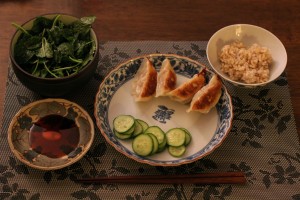
We ate our gyoza with steamed Japanese brown rice, sunomono (vinegared cucumbers) and baby kale salad with Japanese sesame dressing.
Shrimp and Pork Gyoza (Potstickers)
1/2 pound ground pork 1/2 pound shrimp- peeled and deveined and minced relatively fine (chop with your knife or pulse just a few times in a food processor- you don’t want a puree!) 1 cup finely minced cabbage- regular or napa cabbage both work 2 green onions, finely minced 2 cloves of garlic, finely minced 2 tsp minced garlic 1 TBS soy sauce 2 tsp mirin gyoza wrappers (round, not wonton) toasted sesame oil vegetable oil water To serve: soy sauce, rice vinegar, rayu (chili oil) Combine the first 8 ingredients into a bowl, mix well with your hands. Set aside. Set up your work station- get one baking sheet topped with a sheet of wax paper, a clean, damp kitchen towel; a small bowl of water, the gyoza wrappers, a small spoon and the pork/shrimp mixture. Take one gyoza wrapper in your hand, fill it with a heaping teaspoon (as in a spoon you have- not a measuring spoon!) with the mixture, leaving enough space around the edges so you can crimp it without bursting it. Dip your finger in the water bowl and moisten one half of the perimeter of the gyoza wrapper. Fold one half of the wrapper over the mixture, pinching the middle top of the wrapper first. Take your fingers and – with a fold and pinch motion- create the crimps from the outside in on both sides. Put the completed gyoza on the wax paper baking sheet, cover with the damp cloth and repeat until all of the mixture is used. Heat up a cast iron skillet (any skillet will work as long as it isn’t non-stick since you won’t get the nice brown crust!) and add about 1 TBS of vegetable oil and 1 tsp of toasted sesame oil. Heat until almost smoking, then add the gyoza to the pan- leaving just a tiny bit of space in between each. Heat for about 1.5 minutes, then pour in 1/2 cup of water and cover the pan tightly with a lid, letting the gyoza steam for about 3 more minutes. Take the pan off the heat and set it on a wet kitchen towel you have laid on the counter. After one minute, open the lid, take out your gyoza and plate them to serve. To eat gyoza, get a small dish and mix about 1 TBS soy sauce, 1 tsp of rice vinegar and a couple of drops of rayu (more if you like it spicy!). Dip the gyoza into this mixture and enjoy!
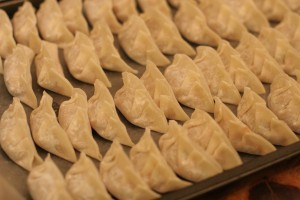
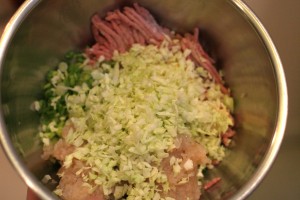
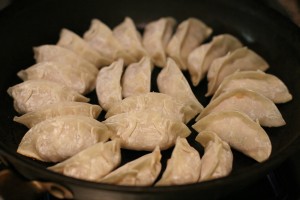

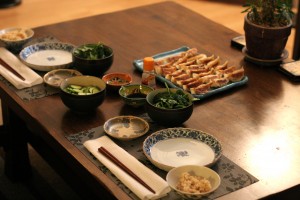

Congratulations for 7 years!!! and your gyozaz look fantastic – ay left overs???
Can’t wait to try these! Thanks for sharing!!
Oh yes. Clare made these for us once and it might be time to revisit.
This time I will apply for the pincher-in-chief role.
C.
M: Thanks Mom:). No leftovers- we ate all of them!
Jen: I hope you do- keep me posted.
Cormac: Ah yes- you will be Master Pincher soon, but it’s worth the work.